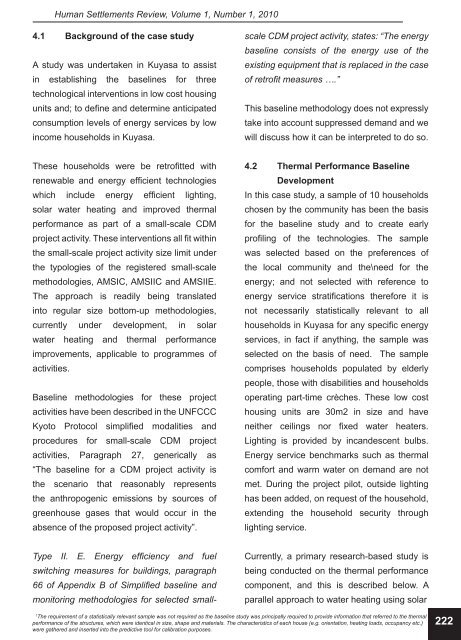Human Settlements Review - Parliamentary Monitoring Group
Human Settlements Review - Parliamentary Monitoring Group
Human Settlements Review - Parliamentary Monitoring Group
You also want an ePaper? Increase the reach of your titles
YUMPU automatically turns print PDFs into web optimized ePapers that Google loves.
<strong>Human</strong> <strong>Settlements</strong> <strong>Review</strong>, Volume 1, Number 1, 2010<br />
4.1 Background of the case study<br />
A study was undertaken in Kuyasa to assist<br />
in establishing the baselines for three<br />
technological interventions in low cost housing<br />
units and; to define and determine anticipated<br />
consumption levels of energy services by low<br />
income households in Kuyasa.<br />
Type II. E. Energy efficiency and fuel<br />
switching measures for buildings, paragraph<br />
66 of Appendix B of Simplified baseline and<br />
monitoring methodologies for selected smallscale<br />
CDM project activity, states: “The energy<br />
baseline consists of the energy use of the<br />
existing equipment that is replaced in the case<br />
of retrofit measures ….”<br />
This baseline methodology does not expressly<br />
take into account suppressed demand and we<br />
will discuss how it can be interpreted to do so.<br />
These households were be retrofitted with<br />
renewable and energy efficient technologies<br />
which include energy efficient lighting,<br />
solar water heating and improved thermal<br />
performance as part of a small-scale CDM<br />
project activity. These interventions all fit within<br />
the small-scale project activity size limit under<br />
the typologies of the registered small-scale<br />
methodologies, AMSIC, AMSIIC and AMSIIE.<br />
The approach is readily being translated<br />
into regular size bottom-up methodologies,<br />
currently under development, in solar<br />
water heating and thermal performance<br />
improvements, applicable to programmes of<br />
activities.<br />
Baseline methodologies for these project<br />
activities have been described in the UNFCCC<br />
Kyoto Protocol simplified modalities and<br />
procedures for small-scale CDM project<br />
activities, Paragraph 27, generically as<br />
“The baseline for a CDM project activity is<br />
the scenario that reasonably represents<br />
the anthropogenic emissions by sources of<br />
greenhouse gases that would occur in the<br />
absence of the proposed project activity”.<br />
4.2 Thermal Performance Baseline<br />
Development<br />
In this case study, a sample of 10 households<br />
chosen by the community has been the basis<br />
for the baseline study and to create early<br />
profiling of the technologies. The sample<br />
was selected based on the preferences of<br />
the local community and the\need for the<br />
energy; and not selected with reference to<br />
energy service stratifications therefore it is<br />
not necessarily statistically relevant to all<br />
households in Kuyasa for any specific energy<br />
services, in fact if anything, the sample was<br />
selected on the basis of need. The sample<br />
comprises households populated by elderly<br />
people, those with disabilities and households<br />
operating part-time crèches. These low cost<br />
housing units are 30m2 in size and have<br />
neither ceilings nor fixed water heaters.<br />
Lighting is provided by incandescent bulbs.<br />
Energy service benchmarks such as thermal<br />
comfort and warm water on demand are not<br />
met. During the project pilot, outside lighting<br />
has been added, on request of the household,<br />
extending the household security through<br />
lighting service.<br />
Currently, a primary research-based study is<br />
being conducted on the thermal performance<br />
component, and this is described below. A<br />
parallel approach to water heating using solar<br />
1<br />
The requirement of a statistically relevant sample was not required as the baseline study was principally required to provide information that referred to the thermal<br />
performance of the structures, which were identical in size, shape and materials. The characteristics of each house (e.g. orientation, heating loads, occupancy etc.)<br />
were gathered and inserted into the predictive tool for calibration purposes.<br />
222









![National Research Foundation Annual Report 2008 / 2009 [Part 2]](https://img.yumpu.com/49774036/1/177x260/national-research-foundation-annual-report-2008-2009-part-2.jpg?quality=85)







